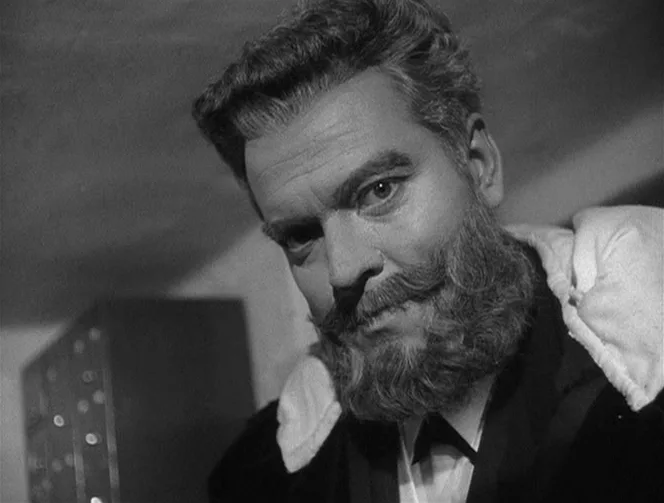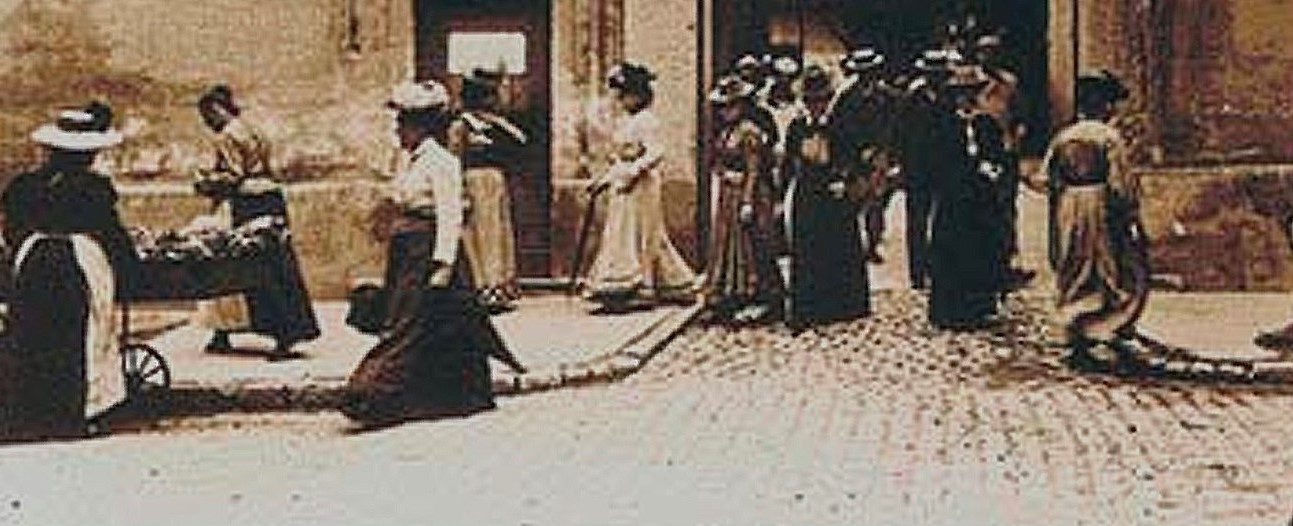France, Spain, Switzerland, 1955
Directed by Orson Welles
With Robert Arden (Guy Van Stratten), Patricia Medina (Mily), Orson Welles (Gregory Arkadin), Paola Mori (Raina Arkadin), Akim Tamiroff (Jakob Zouk), Katina Paxinou (Sophie)

A narrator depicts a strange incident which occurred in the airspace of a European country, the sudden appearance of a small private plane with absolutely no one onboard, not even a pilot, but still flying straight ahead. This caused astonishment and scandal, the narrator notes, claiming then that the film to come is a fictionalized account of what seems to be the real story behind the incident.
What a teaser these words are. They hold the exciting promise of an entertainment relying on a layered and complicated narrative, they suggest a reality born out of a riveting manipulation which indeed deals with a consummate and perverse art of exploiting the first fool coming your way. The dramatic, aerial picture of that pilot-less plane is followed by a stunningly different sequence shot close to the ground, in low angle shots, in a dilapidated town of Germany, featuring a man briskly walking to a building. We are now moving back in time to get to the bottom of the mystery and the voice-over of the first pictures is right away replaced by another voice-over, sounding more anxious and in a hurry, the voice of this walking man: the account takes on a noir’s gritty style and the storytelling starts to look like a collection of Russian dolls.
And indeed, when Guy Van Stratten tries to convince a poor, disheveled, old man named Jakob Zouk, to help him and to flee, he starts to tell stories that occurred long ago. The flashback becomes the introduction to another, far longer, and multifaceted flashback. And that makes the feature a merry-go-round of tales: characters telling their own stories one after the other, either to give away the pieces of the giant, enigmatic jigsaw puzzle the lead character is tasked with solving, or just to entertain, charm, confuse, the essential trait of the film’s other lead character, who is both a boss and a nemesis for Guy Van Stratten.
The starting point for Guy Van Stratten, an American living as a dubious and aimless adventurer, and for his girlfriend, a brunette named Mily, is as grisly as it could be in a noir. The event, shot in even more dramatic low-angle, slanted shots with a stunning depth of field and stark cinematography, is a brief, unexpected talk in the port of Naples with a man who has just been stabbed and promises them fortune if they know how to use the names of a couple of persons. Guy Van Stratten bets he can, and so does Mily. The couple starts to inquire about one of the persons, who turns out to be one of the wealthiest, most influential, and most secretive businessmen in the world, Gregory Arkadin. To get a foothold in his realm, Guy reckons to get in touch with the fellow’s only child, a bright, outgoing young lady named Raina. He gets actually more than he expected. The practical and cheeky daughter is quickly seduced by the unscrupulous, mysterious young lad who is always tailing her while the father, worried that things can go too far between the two, offers Guy Van Stratten an odd job, after intimating he could have got rid of him easily and bluntly.
So Guy Van Stratten becomes an investigator and his brief is, in an astonishing twist, his newfound boss: Gregory Arkadin claims he does not really know what his origins are and wishes to learn about them as fast as possible, fearing folks could learn things about him that could spoil his plans for many new activities and that an awful truth could also upset his cherished Raina. The film becomes a breezy, hectic, and confusing travel around the world and among the many faces of the underworld, pictures from one location on Earth promptly swept away to showcase those of another and completely different location, a remarkable feast of fast editing and boundless imagination, as the investigator ends up meeting amazingly eccentric characters – alone, as his partner has chosen to follow her own instinct and path, unfortunately for her.
But he finds out that Gregory Arkadin is also keen to meet the same people and seems to trail him. Guy Van Stratten’s quest eventually proves to have been a clever scheme, allowing the financier to uncover tracks of folks he used to work with in a criminal enterprise led by a mysterious baroness Sophie. Guy Van Stratten has been coldly used to get rid of those embarrassing ghosts of a disreputable past. And he is in the line of fire too.
The camera has told us as much at the start: not only the snowy, drab background, the panic underpinning the voice and the gait, the tension captured by the low angle shots, but also that spectacular backwards tracking shot as he climbs stairs, looking like a faint figure at the end of an increasingly dark, long tunnel. This is a man whose daring foray in jet-set society and thriving underworld, made even more exciting by the love of smart, rich girl, has always been doomed, faced with the powerful, commanding, haunting person of Gregory Arkadin, whose Mephisto-like face and intimidating attitudes are emphasized by the power of low-angle shots and a splendidly intense, mesmerizing interpretation.
The film wonderfully showcases the visual flair of director Orson Welles, a feast of superb and jarring shots, with an astonishing emphasis on slanted shots and deeply unusual perspectives. In the case of the initial murder, these hyper-spectacular images bluntly signal the world of chaos and terror Guy Van Stratten is about to enter. They inject malaise and disorientation, with wry and grotesque notes, inside the glitzy, carefree frolics of the jet-set life and underline how shady, even vicious most of the motley and maverick folks Guy Van Stratten must talk to used to be. The encounter with Sophie is shot nevertheless in a more tamed, ordinary way – but it is the point where truth is spelled out clearly and it is the character who proves to be more committed to burying the past, forgive and forget. Alas, this is not the point of view of Arkadin.
His ruthlessness, however, is stoked by his deep-seated anxiety about his daughter and the way she can view him. There is a strangely sentimental flaw in that ogre of a man (Raina herself describes him that way), a nucleus of love and fear that proves to be his weakest point – when Guy Van Stratten has a last shot to save his life, he would manipulate Raina through words and lies that hurt Arkadin as he is flying to catch up on his prey. That final, tragic twist leads the last shot of a woeful and shocked young woman driven away from her lover, a pathetic note tinged with even more bitterness for the lead character who ends up losing a lot except his life and giving this quirky, baffling film noir a more tragic, William Shakespeare-like, nature.
Like other projects of Welles, the film was not easy to finance, plan, shoot, and edit. Still little trusted as far as his ability to complete a project and to make it profitable was concerned, Welles struggled after the 1940s to get his films done and he worked in a chaotic fashion. Yet the films stood out as brilliant visual creations, presenting in an incredible way a real artistic coherence given the hurdles, equally attractive and singular, precious if surprising contributions to cinema – like this third attempt at making a noir, after “The Stranger” in 1946 and “The Lady from Shanghai” in 1948, which is also the second time Welles toys with the paramount, riveting, controversial American character of the tycoon (after his 1941 “Citizen Kane”).
There are no less than five versions of “Confidential Report”, aka “Mr. Arkadin”. Three are in the United States, one now in the public domain, another showing a more linear version of the story, yet another listed in the catalog of the American company Corinth Films (a version which was edited under the aegis of the Munich Filmmuseum), while two versions were released in Europe, in Spanish, as most of the film was shot in Spain, and in English, the very one called “Confidential Report” here reviewed.

